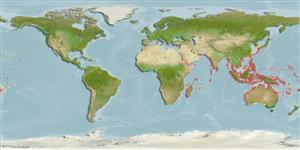Environment: milieu / climate zone / depth range / distribution range
Sinh thái học
Biển; Thuộc về nước lợ Cùng sống ở rạn san hô; không di cư; Mức độ sâu 0 - 6 m (Ref. 86942). Subtropical; 35°N - 36°S, 18°E - 159°W
Indo-West Pacific: Red Sea and East Africa to Samoa, north to the Ryukyu Islands, south to northern Australia and New Caledonia. Migrated to the eastern part of the Mediterranean Sea via the Suez Canal.
Length at first maturity / Bộ gần gũi / Khối lượng (Trọng lượng) / Age
Maturity: Lm 23.1, range 18 - ? cm
Max length : 45.0 cm TL con đực/không giới tính; (Ref. 30573); common length : 30.0 cm TL con đực/không giới tính; (Ref. 5450); Tuổi cực đại được báo cáo: 4 các năm (Ref. 126539)
Các tia vây lưng cứng (tổng cộng) : 0; Các vây lưng mềm (tổng cộng) : 12 - 15; Tia cứng vây hậu môn: 0; Tia mềm vây hậu môn: 10 - 12. Greatly prolonged, beak-like lower jaw; upper jaw short, triangular and without scales; preorbital ridge absent; total number of gill rakers on first gill arch 25-36; pectoral fins short, not reaching past nasal pit when folded forward; with 3-9 (usually 4-6) vertical bars on the sides. (Ref. 9843). Color bluish dorsally, silvery on sides. 36-41 predorsal scales. Lower lobe of caudal fin longer than upper lobe. Dorsal and anal fins located posteriorly.
Occur in coastal waters of high islands and continental shorelines; generally in areas rich in vegetation (Ref. 5213) and sand flats (Ref. 48635). Form schools. Adults feed mainly on seagrasses, to a lesser extent on green algae and diatoms (Ref. 9843). Breed in estuaries (Ref. 4164). Marketed fresh and dried salted (Ref. 5284, 9843); meat tasty (Ref. 637). Also caught with dragnets (Ref. 30573) and dipnets.
Collette, B.B. and J. Su, 1986. The halfbeaks (Pisces, Beloniformes, Hemiramphidae) of the Far East. Proc. Acad. Nat. Sci. Philadelphia 138(1):250-301. (Ref. 10943)
IUCN Red List Status (Ref. 130435: Version 2024-2)
Threat to humans
Harmless
Human uses
Các nghề cá: Tính thương mại; cá để chơi: đúng; mồi: occasionally
Các công cụ
Special reports
Download XML
Các nguồn internet
Estimates based on models
Preferred temperature (Ref.
123201): 24.7 - 29.3, mean 28.5 °C (based on 3383 cells).
Phylogenetic diversity index (Ref.
82804): PD
50 = 0.5005 [Uniqueness, from 0.5 = low to 2.0 = high].
Bayesian length-weight: a=0.00380 (0.00290 - 0.00498), b=3.07 (3.01 - 3.13), in cm total length, based on LWR estimates for this species (Ref.
93245).
Mức dinh dưỡng (Ref.
69278): 2.7 ±0.30 se; based on food items.
Thích nghi nhanh (Ref.
120179): Chiêù cao, thời gian nhân đôi của chủng quần tối thiểu là dưới 15 tháng (Preliminary K or Fecundity.).
Fishing Vulnerability (Ref.
59153): Low to moderate vulnerability (35 of 100).
Nutrients (Ref.
124155): Calcium = 61.2 [21.4, 168.3] mg/100g; Iron = 0.643 [0.265, 1.468] mg/100g; Protein = 18.8 [16.1, 21.2] %; Omega3 = 0.165 [0.067, 0.461] g/100g; Selenium = 12.5 [4.9, 32.5] μg/100g; VitaminA = 39.7 [9.5, 186.7] μg/100g; Zinc = 1.06 [0.61, 1.80] mg/100g (wet weight); based on
nutrient studies.
